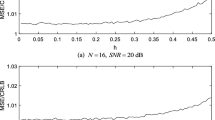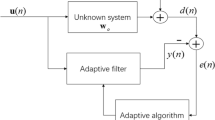Abstract
Wideband spectrum sensing is a critical component of a functioning cognitive radio system. Its major challenge is the too high sampling rate requirement. Compressive sensing (CS) promises to be able to deal with it. Nearly all the current CS-based compressive wideband spectrum sensing methods exploit only the frequency sparsity to perform. This paper sets up a new signal model which is sparse in both temporal and frequency domain. Motivated by the achievement of a fast and robust detection of the wideband spectrum change, total variation minimization is incorporated to exploit the temporal and frequency structure information to enhance the sparsity level. As a sparser vector is obtained, the spectrum sensing period would be shortened and sensing accuracy would be enhanced. Both theoretical analysis and numerical experiments demonstrate the performance improvement.





Similar content being viewed by others
References
Sahai A, Cabric D (2005) Spectrum sensing—fundamental limits and practical challenges. In: A tutorial presented at IEEE DySpan Conference 2005, Baltimore
Saeedzarandi M, Paeiz A (2013) Cooperative multiband joint detection in cognitive radio networks using artificial immune system. Ann Telecommun–Annales des Telecommunications 68(3–4):239–246
Haykin S (2005) Cognitive radio: brain-empowered wireless communications. IEEE J Sel Areas Commun 23(2):201–220
Moy C, Doyle L, Sanada Y (2009) Foreword-cognitive radio: from equipment to networks. Ann Telecommun–Annales des Tlcommunications 64(7):415–417
Mitola J III (2009) Cognitive radio architecture evolution: annals of telecommunications. Ann Telecommun–Annales des Tlcommunications 64(7):419–441
Hamdoun H, Loskot P, O’Farrell T, He J (2012) Survey and applications of standardized energy metrics to mobile networks. Ann Telecommun–Annales des Tlcommunications 67(3–4):113–123
Ghasemi A, Sousa ES (2008) Spectrum sensing in cognitive radio networks: requirements, challenges and design trade-offs. IEEE Commun Mag 46(4):32–39
Li C, Chen W, Wang B, Zhang X, Chen H, Yang D (2011) System-level simulation methodology and platform for mobile cellular systems. IEEE Commun Mag 49(7):148–155
Wang G, Chen H (2011) An importance sampling method for TDOA-based source localization. IEEE Trans Wirel Commun 10(5):1560–1568
Donoho D (2006) Compressed sensing. IEEE Trans Inf Theory 52(4):1289–1306
Candes EJ, Romberg J, Tao T (2006) Robust uncertainty principles: exact signal reconstruction from highly incomplete frequency information. IEEE Trans Inf Theory 52(2):489–509
Candes EJ, Wakin MB (2008) An introduction to compressive sampling. IEEE Signal Proc Mag 25(2):21–30
FCC (2002) Spectrum policy task force report. ET docket no. 02-155. FCC, Washington
Tian Z, Giannakis GB (2007) Compressed sensing for wideband cognitive radios. In: International conference on acoustics, speech, and signal processing 2007, vol 4, 15–20, April, pp IV-1357–IV-1360
Tian Z (2008) Compressed wideband sensing in cooperative cognitive radio networks. In: Proceedings of IEEE Globecom conference, New Orleans, Dec., pp 1–5
Tian Z, Blasch E, Li W, Chen G, Li X (2008) Performance evaluation of distributed compressed wideband sensing for cognitive radio networks. In: Proceedings of the ISIF/IEEE International Conference on Information Fusion (FUSION), Cologne, July, pp 1–8
Elsner JP, Braun M, Jakel H, Jondral FK (2009) Compressed spectrum estimation for cognitive radios. In: Proceedings of 19th Virginia Tech symposium on wireless communications, Blacksburg, Jun., pp 1–4
Wang Y, Pandharipande A, Polo YL, Leus G (2009) Distributed compressive wide-band spectrum sensing. In: IEEE proceedings of information theory application (ITA’ 09), San Diego, Feb, pp 1–4
Polo YL, Wang Y, Pandharipande A, Leus G (2009) Compressive wideband spectrum sensing. In: International conference on acoustics, speech, and signal processing (ICASSP 2009), vol 00, pp 2337–2340
Liu Y, Wan Q (2011) Anti-sampling-distortion compressive wideband spectrum sensing for cognitive radio. Int J Mob Commun 9(6):604–618
Liu Y, De Vos M, Van Huffel S (2012) Robust sparse signal recovery for compressed sensing with sampling and representation uncertainties. Internal Report 12-177, ESAT-STADIUS, KU, Leuven, Nov
Liu Y, Wan Q (2012) Compressive wideband spectrum sensing for fixed frequency spectrum allocation. arXiv preprint arXiv:1005.1804
Liu Y, Wan Q (2012) Enhanced compressive wideband frequency spectrum sensing for dynamic spectrum access. EURASIP J Adv Signal Process 2012(177):1–17
Romberg J (2008) Imaging via compressive sampling introduction to compressive sampling and recovery via convex programming. IEEE Signal Proc Mag 25(2):14–20
Liu Y, Wan Q (2010) Robust beamformer based on total variation minimization and sparse constraint. Electron Lett 46(25):1697–1699
Laska JN, Kirolos S, Massoud Y, Baraniuk R, Gilbert A, Iwen M, Strauss M (2006) Random sampling for analog-to-information conversion of wideband signals. In: IEEE Dallas circuits and systems workshop (DCAS), pp 119–122
Laska JN, Kirolos S, Duarte MF, Ragheb TS, Baraniuk RG, Messoud Y (2007) Theory and implementation of an analog-to-information converter using random demodulation. In: IEEE international symposium on circuits and systems (ISCAS), pp 1959–1962
Yu Z, Hoyos S, Sadler BM (2008) Mixed-signal parallel compressed sensing and reception for cognitive radio. In: IEEE international conference on acoustics, speech, and signal processing 2008 (ICASSP 2008), March 30–April 4, Las Vegas, pp 3861–3864
Mishali M, Eldar YC (2009) Xampling. Part I: practice. CCIT report no. 747, EE Dept., Technion-Israel Institute of Technology, arXiv:0911.0519
Mallat S, Zhang Z (1993) Matching pursuit in a time-frequency dictionary. IEEE Trans Signal Process 41(12):3397–3415
Tropp JA, Gilbert AC (2007) Signal recovery from random measurements via orthogonal matching pursuit. IEEE Trans Inf Theory 53(12):4655–4666
Chen SS (1995) Basis pursuit. Department of Statistics, Ph. D dissertation, Stanford University
Chen SS, Donoho DL, Saunders MA (1999) Atomic decomposition by basis pursuit. SIAM J Sci Comput 20(1):33–61
Tibshirani R (1996) Regression shrinkage and selection via the lasso. J R Stat Soc B 58:267–288
Efron B, Johnstone I, Hastie T, Tibshirani R (2004) Least angle regression. Ann Stat 32(2):407–499
Kim S-J, Koh K, Lustig M, Boyd S, Gorinevsky D (2007) An interior-point method for large-scale l1-regularized least squares. IEEE J Sel Top Signal Process 1(4):606–617
Kim S-J, Koh K, Lustig M, Boyd S, Gorinevsky D (2007) An interior-point method for large-scale l1-regularized least squares. In: Proceedings international conference on image processing (ICIP), vol 3, pp III-117–III-120, September
Candes E, Tao T (2007) The Dantzig selector: statistical estimation when p is much larger than n. Ann Stat 35(6):2313–2351
Grant M, Boyd S, Ye Y (2008) CVX: Matlab software for disciplined convex programming. http://www.stanford.edu/boyd/index.html
Sturm J (1999) Using sedumi 1.02, a MATLAB toolbox for optimization over symmetric cones. Optim Methods Softw 11(12):625–653
Wen F, Wan Q, He G, Zhang P, Liu Y (2013) Wideband direction of arrival estimation with linear array: analysis and closed-form formulae. Chin J Electron 22(4):779–783
Wang C, Chen H, Yin Q, Feng A, Molisch AF (2011) Multi-user two-way relay networks with distributed beamforming. IEEE Trans Wirel Commun 10(10):3460–3471
Liang J, Zeng X, Wang W, Chen H (2011) L-shaped array-based elevation and azimuth direction finding in the presence of mutual coupling. Signal Process 91(5):1319–1328
Avonds Y, Liu Y, Van Huffel S (2013) Simultaneous greedy analysis pursuit for compressive sensing of multi-channel ECG signals. Internal Report 13–82. ESAT-STADIUS, KU, Leuven
Huang X, Liu Y, Shi L, Van Huffel S, Suykens J (2013) Two-level L1 optimization for compressed sensing. Internal report 13–123. ESAT-STADIUS, KU, Leuven
Liu Y, De Vos M, Gligorijevic I, Matic V, Li Y, Van Huffel S (2013) Multi-structural signal recovery for biomedical compressive sensing. IEEE Trans Biomed Eng 60(10):2794–2805
Acknowledgments
Yipeng Liu was supported by FWO PhD/postdoc grant G.0108.11 (compressed sensing). Qun Wan was supported in part by the National Natural Science Foundation of China under the grant 61172140, and 985 key projects for excellent teaching team supporting (postgraduate) under the grant A1098522-02.
Author information
Authors and Affiliations
Corresponding author
Rights and permissions
About this article
Cite this article
Liu, Y., Wan, Q. Compressive slow-varying wideband power spectrum sensing for cognitive radio. Ann. Telecommun. 69, 559–567 (2014). https://doi.org/10.1007/s12243-013-0414-3
Received:
Accepted:
Published:
Issue Date:
DOI: https://doi.org/10.1007/s12243-013-0414-3




